Bulgan 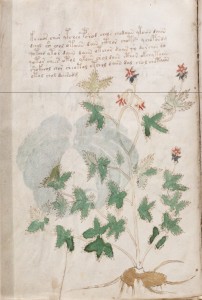 Description
Description
Plant 5v occupies about 2/3 of the page and is positioned under a 5 1/3-line block of text. The plant has an interesting oval shape in the center, rather decorative looking, a profusion of serrated or toothed leaves somewhat asymmetric in distribution (as opposed to a mint plant, for example, which branches very regularly).
There is a rounded brownish root with medium-thick tendrils extending out to the sides. The stem is only very lightly colored, with a soft brownish wash.
The leaves are mostly green, although some have been left lighter and some slightly brownish. It appears that the leaves of this plant may not be highly consistent in color or perhaps it’s later in the season and some leaves have begun to wither.
The flowers are at the ends of the stalks, have five petals, are colored red, a color not often used in the VM (most of the reds are brick red) and the calyx has been colored blue on the inside, but remains unpainted on the outside. A couple of the heads nod. This may be a characteristic of the plant or it may be a means of showing the flowerheads from a different angle.
The somewhat irregular, meandering path of the stems looks to me like this may be a vine, and since vines often intertwine, the oval shape in the top center may simply be a way of representing an intertwining vine.
http://landmarkinn.com/google.php Previous Identifications
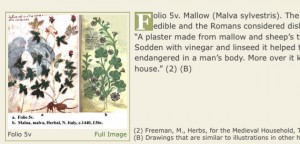 Edith Sherwood has identified this as Malva sylvestris. While there are some similarities, there are also some significant differences. Malva leaves have a more fanlike shape, while Plant 5v appears more palmate serrated. Malva flowers emerge from the stem nodes, while the VM plant shows the flowers more concentrated at the ends of individual stalks. The ends of the petals of Malva tend to be broader and blunter than Plant 5v, which as more pointed petals. Malva roots tend not to be as tumescent as the root on Plant 5v.
Edith Sherwood has identified this as Malva sylvestris. While there are some similarities, there are also some significant differences. Malva leaves have a more fanlike shape, while Plant 5v appears more palmate serrated. Malva flowers emerge from the stem nodes, while the VM plant shows the flowers more concentrated at the ends of individual stalks. The ends of the petals of Malva tend to be broader and blunter than Plant 5v, which as more pointed petals. Malva roots tend not to be as tumescent as the root on Plant 5v.
Other Possibilities
The petals and plump root lead one to wonder if the VM plant is Anemone, for example, Anemone hortensis. It has palmate leaves, the stems curve somewhat, and the flower petals are a bright cheery red. But it’s not quite a match to Plant 5v. A. hortensis has more than five petals, the hairs emerging from the fleshy part of the root tend to travel down rather than sideways (and are finer), and the calyx doesn’t come up around the base of the flower in the same way as illustrated in Plant 5v. Also, A. hortensis leaves, while being palmate, are not serrated or toothed.
Many of the same things could be said of Paeonia officinalis. It has palmate leaves, bright red flowers, thickened roots, and stems that sometimes curve. But the leaves are really more odd pinnate than palmate, they’re not serrated, and the bumpy roots tend to orient more downward than sideways and to be connected with “strings” in a way that isn’t emphasized in the VM plant. There are five petals, but the calyx doesn’t quite match Plant 5v.
Potentilla has palmate leaves very similar to Voynich 5v, a vine-like quality and can sometimes have significantly enlarged roots, but the flowers are usually yellow and there are four petals, typically with more rounded margins than Plant 5v, rather than five.
Other than the roots and serrated, palmate leaves, the VM plant doesn’t resemble Aconitum (Monk’s hood) or Acanthus. Aconitum and Acanthus have distinct upward-growing stalks and a spike of hooded flowers quite different from the viny, more delicate nature of Plant 5v.
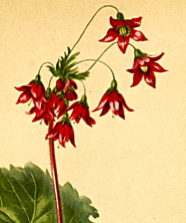 Cortusa matthioli warrants some consideration. It has enlarged roots, somewhat palmate, serrated leaves (though not as distinctly palmate as the VM plant), a somewhat curvy appearance, and lovely fucschia-colored starlike blossoms at the ends of the stalks, each with five petals. Of particular interest is the way some of the flowers nod more than others, just as shown in the VM drawing. But there are also differences. Cortusa has a more upright, rather than viny, growth habit, most of the leaves come from the base, just above the root, rather than along branching stems, and the single stem extends quite far from the lower leaves. It resembles Saxifrage or Primulus in general proportions rather than looking like a vine with leaves coming from the nodes as in Plant 5v. Still, it might be worth keeping Cortusa on the table, at least for now.
Cortusa matthioli warrants some consideration. It has enlarged roots, somewhat palmate, serrated leaves (though not as distinctly palmate as the VM plant), a somewhat curvy appearance, and lovely fucschia-colored starlike blossoms at the ends of the stalks, each with five petals. Of particular interest is the way some of the flowers nod more than others, just as shown in the VM drawing. But there are also differences. Cortusa has a more upright, rather than viny, growth habit, most of the leaves come from the base, just above the root, rather than along branching stems, and the single stem extends quite far from the lower leaves. It resembles Saxifrage or Primulus in general proportions rather than looking like a vine with leaves coming from the nodes as in Plant 5v. Still, it might be worth keeping Cortusa on the table, at least for now.
Manihot could be considered also. It has swollen roots, flowers at the ends of the stalks, and reddish stems but the leaves are more digitate than palmate and are not serrated.
There are some Geraniums that merit consideration, that have enlarged roots, palmate leaves, sometimes of gently curving stems, flowers at the ends of the stems that are sometimes red or bright pink, but the flower heads tend to have more flowers on each, in some cases arranged in umbels, and the petals tend to be more rounded than starlike.
Ranunculus shares many characteristics with wild Geranium in addition to which, it has a more viny habit than Geranium, setting out runners to propagate more plants. While many Ranunculus have a thick mass of tendrils, some species have bulbous roots. The leaves tend to be more lacinate than the VM plant, and some are quite rounded (similar to strawberry plants), but some are similar to VM 5v, as well. Most Ranunculus are yellow, but some are pink. The main difference between Ranunculus and Plant 5v is that Ranunculus petals tend to be very rounded, rather than pointed.
Potentilla and Ranunculus can be hard to tell apart, they share similar leaves, growth patterns, and blossoms, except that Potentilla has four petals, Ranunculus five. VM 5v has five.
Osmorhiza shares some characteristics with Plant 5v. It has a fleshy root, palmate, leaves (although they are more frondlike- than 5v), and delicate flowers at the ends of the stems, but the flowers tend to be arranged in umbels and are typically white. The calyx is more vase-shaped as the plant nears fruiting and the flower petals less distinct than Plant 5v.
Where vines are concerned, Convolvulus should always be considered, and it has enlarged roots (I always use the term “root” loosely since some roots are actually swollen stems rather than swollen roots), but the leaves tend to be larger and not quite so distinctly palmate as Plant 5v, and more importantly, the flowers are trumpet-shaped, with fused petals, rather than small and star-like.
The South American giant potato, a vine with somewhat palmate leaves, might be in the running, but the flowers are more trumpet-shaped and the leaves often more digitate, and unserrated.
I think it’s more likely that Plant 5v is Bryonia. Bryonia roots are more swollen than Malva, and have additional tendrils shooting out to the sides. The leaves are palmate, as in the VM drawing, and the flowers are more concentrated at the ends of individual branching vines. The petals of Bryonia are pointed, and more starlike than Malva and the calyx tips peek out from between the flower petals as they do in the VM drawing. The meandering quality of the VM plant is quite typical of Bryonia. The parts that don’t fit the VM drawing are the lack of tendrils (Bryonia has very distinct spiraling tenrils), and the color of the flowers. Bryonia flowers are almost always white, occasionally yellow. Red flowers, especially a red that stands out from other reds in the Voynich Manuscript, isn’t characteristic of Bryonia.
Nevertheless, in terms of the other characteristics, Bryonia should probably be considered. Is it possible Plant 5v flowers are painted red because they eventually turn into red berries? That might be a stretch, but until a better contender than Bryonia is found, maybe it’s possible. Or maybe the VM plant is something related to Bryonia, which is from the Cucurbitaceae family.
J.K. Petersen
Postscript Jan. 18, 2018: Since I originally posted the above blog, in July 2013, more public domain images have become available, so I am including them now, so you can see why I feel that Geranium/Pelargonium/Erodium should be considered as one of the possibilities for this plant. Many geranium species have palmate leaves, and some of them, like the one on the right (G. maculatum) and the larger picture at the bottom (G. glutinosum), have somewhat viny stalks that curve a bit and spread more than some of the upright species.
Geraniums (often called stork’s bill or crane’s bill) are commonly represented in medieval herbal manuscripts and books of recipes (with Geranium sanguineum as one example). Geranium palustre (which also resembles the VMS drawing) is said to have been spread across Europe by soldiers packing fodder for their horses and mules:
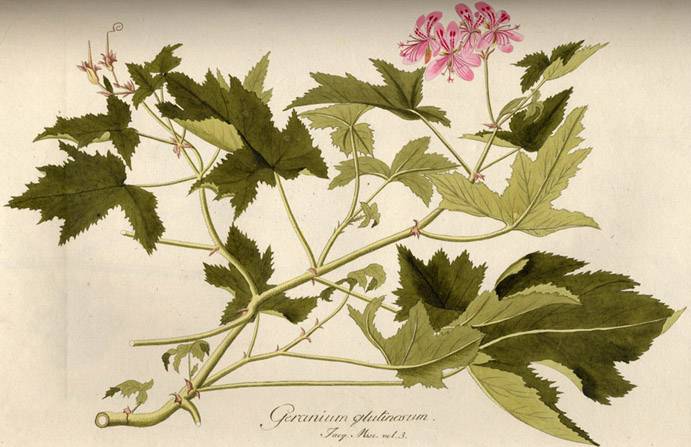 Geranium robertianum (a very widespread plant also known as herb Robert) was used medicinally in the early days, and is still used as a mosquito repellent:
Geranium robertianum (a very widespread plant also known as herb Robert) was used medicinally in the early days, and is still used as a mosquito repellent:

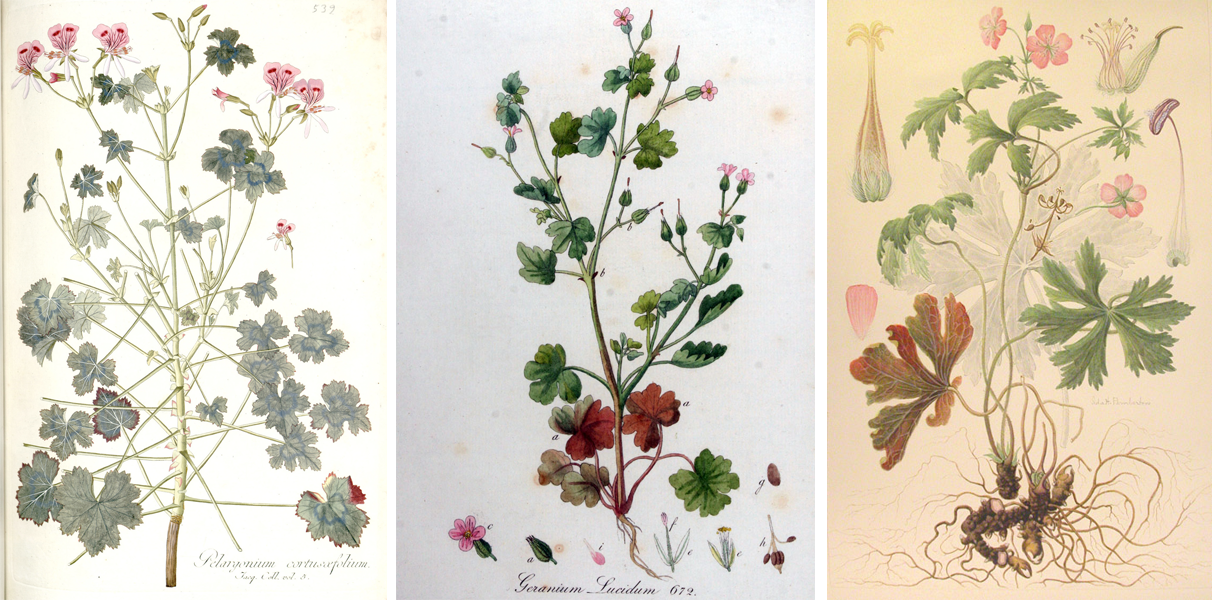
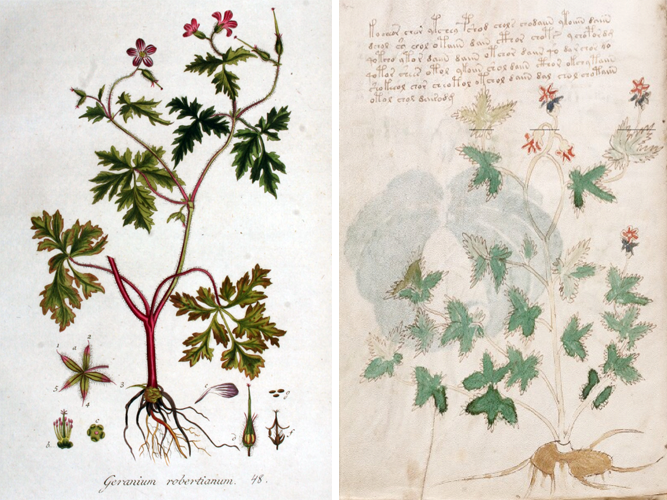
When I first saw this drawing I said: Comarum palustre.
I’m sorry I didn’t see your comment when you originally posted it (after a couple of years have passed I forget to check older blogs for comments), but I can see why you would think Comarum palustre. It has palmate leaves, is slightly viny, has magenta-colored flowers and is mostly upright. It is also widespread across Europe and western Asia.
I have it on my list but I think the reason I didn’t include it in the blog is because the leaves are quite long and thin and the flowers larger than the VMS drawing and quite ornate (with several rows of “petals”), but perhaps I should have. If the VMS drawing is a mostly naturalistic but slightly simplified version of a plant then Comarum palustre (Potentilla palustris—marsh cinquefoil), should probably be on the list.